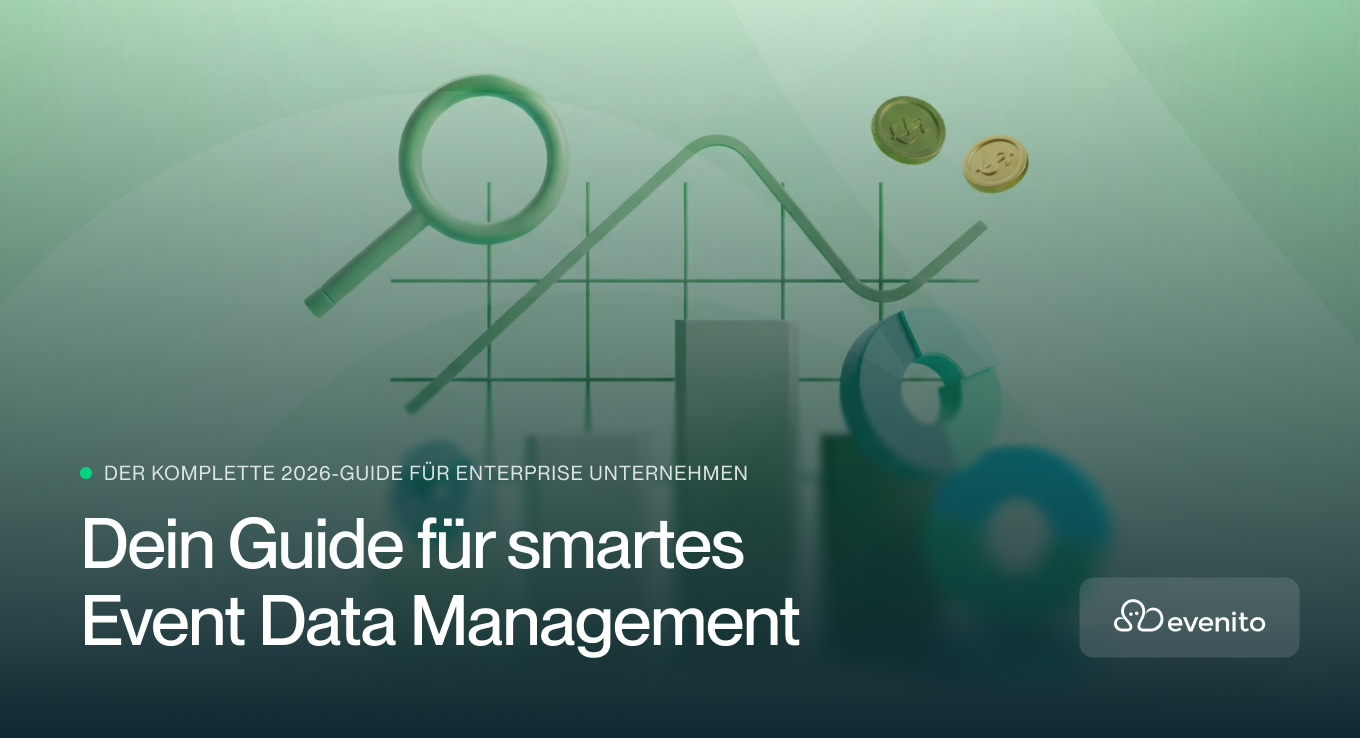Handling feedback and criticism after a B2B event: How to collect and implement constructive feedback
After the event is before the event. What does that mean? Ideally, once you’ve wrapped up the management of one event, you’ll jump straight into preparing the next one. In this case, applying what you learned from the first event is essential to ensure you can plan and execute the next trade fair, workshop or festival flawlessly and more efficiently.
This is especially true for business-to-business (B2B) events. Business partners, in particular, have the potential to become long-term customers, allowing you to position yourself as the go-to event manager for all corporate events.
In this blog, we’ll explore the value of evaluating and gathering feedback from B2B events. We’ll also explain why this feedback is important and how you can collect and implement it effectively.
Business vs. customers vs public
Events can be differentiated into three large target group segments: business, customers and the public. Different types of events are suitable for these three categories, as the goals, requirements and expectations of the intended audiences can be very different.
B2B events: Business to business
These refer to business functions with a target group including business partners, retailers and employees. The content of these events generally focuses on passing on information. Typical types of B2B events include trade fairs, networking functions, conferences, workshops, product presentations, charity events and celebrations to mark company anniversaries. Trade fairs are a speciality in this context, as they are often intended for all three target group segments simultaneously. Since the Coronavirus pandemic, the B2B sector has also increasingly hosted digital or hybrid events, with events even as large as trade fairs taking place online.
Overall, B2B events tend to have a more formal and sophisticated style, depending on what a company wants to celebrate or present.
B2C events: Business to customers
These events are directly targeted at end customers. The primary goal of such functions is to showcase products and strengthen the company’s image. The most classic examples of events in the B2C sector are consumer fairs, such as Art International Zurich, Gamescom in Cologne, the Frankfurt Book Fair, and Auto Zurich. Additionally, exhibitions or events where customers can be visited directly also fall into this category.
B2P events: Business to public
The focus of events in the B2P segment is the general public. While the press is an important element for all types of functions, the involvement of editors and journalists is even more central in B2P events. They are intended to enhance the company’s image, making well-crafted press relations crucial. Examples include press conferences and corporate presentations, such as an open house day.
B2B event focus: Utilising feedback
The explanations above show there are overlaps in the three event segments. Sometimes events cannot be clearly assigned to one area, and this should be taken into account for event management. Our focus here, however, is on business-to-business events.
After a successful B2B event, it is important to collect feedback. Gathering both positive input and criticism from participants is extremely valuable. Not only does it provide insight into your own performance in terms of event management, but it also gives you information on the wants and needs of your B2B target group.
Evaluations allow you to identify the strengths and weaknesses of the event and improve future ones. This way, you can better meet participant expectations the next time around.
By accepting and implementing constructive criticism and suggestions for improvements, you also show appreciation to the participants and customers. A structured approach to feedback can increase the long-term quality of your events and strengthen the reputation of both your event agency and your clients’ companies.

How to measure B2B event success
While the style of B2B events is generally similar, no two events are the same. With that said, there are some elements by which you can measure success, and these should certainly be included in your event evaluation.
Networking opportunities:
Networking is a crucial factor for B2B events and their participants. To measure this, consider asking participants in a feedback questionnaire how many new contacts they made, how useful they found the networking sessions, and whether they were able to establish meaningful business relationships.
Engaging speakers:
High-profile keynote speakers are a real crowd puller. Especially in a professional setting, there is enormous interest in hearing lectures from experts in one’s own industry. Measure the success of this element by asking attendees to rate the quality of the speakers, the relevance of the topics discussed, and whether the presentations provided actionable insights.
Entertainment:
As already mentioned, B2B events are about gaining and exchanging information. To prevent mental fatigue and avoid overwhelming your audience, breaks are important. Entertainment elements provide variety and open up networking opportunities. You can evaluate this aspect by gathering feedback on how engaging and enjoyable participants found the entertainment portions of the event.
Event technology:
In times of hybrid and digital events, technology is essential. During an online event, success depends heavily on how well the technology functions. In your feedback, ask participants if they faced any technical difficulties, how smooth the registration and digital platforms were, and whether they found the virtual experience seamless. This feedback can inform you about the effectiveness of your event’s technological infrastructure.

Methods for collecting feedback
Once you've established the criteria for measuring the success of your B2B event, it's essential to implement effective methods for collecting feedback. By utilizing a combination of approaches, you can gather diverse insights that will help you understand participant experiences and identify areas for improvement. Here are some effective methods to consider:
Post-event surveys:
One effective way to gather feedback is by sending a concise questionnaire as part of a post-event survey to participants. This method helps you collect both quantitative and qualitative data, making it easy to assess multiple aspects of the event. To ensure a higher response rate and more actionable insights, keep the survey brief—ideally limited to five multiple-choice questions, including those that ask participants to rate their experiences. Ensure the questions align with your Key Performance Indicators (KPIs).
As an example, the following questions and their corresponding KPIs could be included in your survey:
- How would you rate the overall organisation of the event? (KPI: Average satisfaction score out of 5)
- How many new business contacts did you make? (KPI: Average number of new contacts per participant)
- How satisfied were you with the event’s content or sessions? (KPI: Percentage of attendees rating content as satisfactory or above)
- How useful were the networking opportunities provided? (KPI: Average usefulness rating out of 5)
- What would you suggest for improving the event next time? (KPI: Percentage of suggestions implemented in future events)
Personal discussions and telephone interviews:
Personal contact always means a considerable time commitment. Nevertheless, it is recommended to utilise this type of feedback collection. Especially when it comes to customers, you should contact them personally after the event to discuss it together. These informal discussions can uncover immediate reactions, suggestions, and sentiments that might not be captured in a formal survey.
Focus groups:
Conducting focus groups is also time-consuming. In these group discussions, however, you not only get individual impressions from people, but you also gather group dynamic feedback. This method can help you dive into specific aspects of the event, encouraging detailed feedback and collaborative brainstorming for future improvements.
Social media:
Social networks are very useful for evaluating B2B events. They provide spontaneous and unfiltered ad hoc impressions of the function. Monitoring social media platforms for mentions and comments about your event can provide real-time feedback. Encourage attendees to share their experiences online, and consider using specific hashtags related to the event. This can help you gauge overall sentiment and identify areas for improvement.
Each of these collection methods has advantages and disadvantages, and a combination of several approaches often yields the best results.

Designing effective feedback surveys
To obtain useful information, you should invest some time in the design of your surveys. The questions should cover both quantitative and qualitative aspects. One option is to use a rating scale to measure satisfaction across different event areas. Combine this with open-ended questions that allow for free-text responses to gather detailed comments and suggestions.
The survey should be concise and to the point. Especially in the business world, people don’t always have the time to fill out a 15 to 20 minute survey. Aim to limit the completion time to about five minutes, as this will also increase the response rate.
A logical structure and appealing design will further motivate your target audience to complete the survey. Make sure it’s easily accessible, whether through an email link or via a mobile app.
Using digital tools for feedback collection
Digital tools offer numerous advantages for collecting feedback. Online survey platforms, such as SurveyMonkey, Google Forms and LimeSurvey, allow you to quickly and efficiently gather and analyse feedback. Some of these tools even enable real-time data collection during the event. These tools and software generally provide integrated analysis features, making it easier to identify patterns and trends.
Mobile apps and event management software, such as evenito, also offer options for real-time feedback collection.
Social media monitoring tools, such as Hootsuite and Brandwatch, can be used to track comments and discussions on platforms like Twitter and LinkedIn.
Analysing and evaluating collected feedback
To benefit from the surveys, thorough analysis after feedback collection is essential. Consider both quantitative and qualitative data.
➡ Quantitative data from closed questions can be statistically analysed to determine averages and trends.
➡ Qualitative data from open-ended questions requires content analysis to identify recurring themes and specific suggestions for improvement.
Modern analytics tools that incorporate text analysis can simplify this evaluation process. A structured and systematic feedback analysis allows you to make informed decisions for future events.
Identifying recurring themes and patterns
What’s most important when analysing feedback? Capturing the overall sentiment of the majority, of course. Identifying patterns and recurring themes in your responses is a central task of feedback analysis.
Patterns and recurring themes provide clues about the event’s fundamental strengths and weaknesses. For example, repeated praise for the quality of presentations might indicate that this aspect was particularly well-received, while frequent criticism about catering suggests room for improvement.
Identifying patterns requires careful review and categorisation of feedback comments. However, modern analytics tools can assist you, for example, by automatically recognising and visualising common keywords and themes.
Developing an action plan to implement feedback
Once you’ve collected and analysed the feedback, you can start to implement concrete initiatives. In the first step, prioritise the key areas for improvement based on the identified strengths and weaknesses, and assign responsibilities.
Let’s take the example of catering: If, for instance, 65% of your survey participants complained that the food was cold, over-salted or there was simply not enough, then action is required! Set up a meeting with the catering provider. Try to determine whether it was a one-time quality issue or if there is a more fundamental problem. If the latter is the case, it would be clear that you shouldn’t hire this provider again and should instead look for alternatives.
To stay organised, be sure to set clear goals and a timeline for implementing all defined measures, and regularly review your progress. Involving the entire event team and clearly communicating the planned steps are crucial to success.
Communicating improvements to participants
The entire process of collecting feedback, analysing it and adjusting accordingly takes valuable time. To ensure this investment of resources pays off, you should communicate improvements to participants and stakeholders once they have been implemented.
In this way, you show that their feedback has been taken seriously and concrete measures have been taken to improve future events.
You can communicate the adjustments through a thank you email, a blog post or a social media post, for example. Transparent communication strengthens participants’ trust and promotes long-term participant loyalty.
Long-term strategies for continuous improvement
It makes sense to develop a long-term strategy for collecting, processing and implementing feedback for your B2B events. A defined process not only makes your work easier, but it also turns feedback into a scheduled, routine task.
Through continuous evaluation, you can ensure event quality and increase the satisfaction of both your customers and participants.
When regularly gathering feedback, both during and after the event, you can also rely on smart technology. Using tools and software is not only worthwhile for analysis and pattern recognition, but it also helps with event preparation and participant management. Intelligent software solutions save you valuable time and resources.
Key takeaways
Feedback is valuable input that can be used to improve your B2B events. It shows you the strengths and weaknesses of your events as well as the wants and expectations of stakeholders and participants. With a structured approach, you can take full advantage of the power of feedback.
By combining various collections methods—such as digital surveys, personal interviews, focus groups and social media—with smart analysis tools and software, you can quickly and efficiently obtain an overview of your feedback. Recurring themes and patterns you identify can serve as the foundation for improvements. Based on this, you can identify, prioritize, and implement tailored and concrete improvement initiatives. Long-term strategies for continuous feedback collection and implementation offer the best prospects for generating sustainable improvements and success.
A systematic and constructive approach to feedback is a win-win for all those involved. So, start today by systematically collecting and utilising feedback from your event participants and stakeholders!


.svg)



